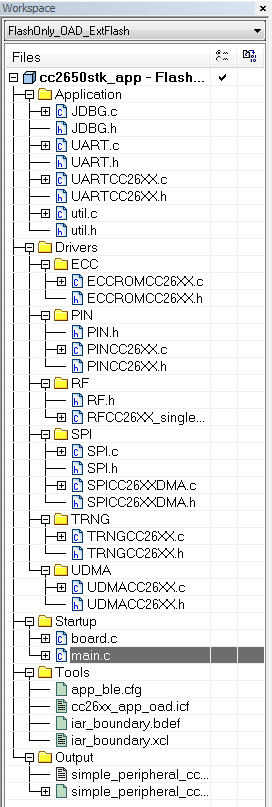Other Parts Discussed in Thread: CC2640,
Tool/software: TI-RTOS
Hi all,
I am trying to do a project on CC2640 with BLE SDK 2.02, but for some reasons, I will disable the BLE features on such a BLE processor.
So I make a new project like this. (modified from the simple_peripheral project of CC2650STK)
Also, I modified the main function as
int main()
{
PIN_init(BoardGpioInitTable);
Power_setConstraint(PowerCC26XX_SB_DISALLOW);
Power_setConstraint(PowerCC26XX_IDLE_PD_DISALLOW);
/* Initialize ICall module */
//ICall_init();
JDBGInit();
BIOS_start(); /* enable interrupts and start SYS/BIOS */
return 0;
}
I guess this must be the easiest project.
The JDBGInit() is the UART Init function. If the UART Init successfully, the UART will print a character 'a' with \r\n.
Here is the JDBGInit():
void JDBGInit(){
UART_init();
UART_Params_init(&JDBGParams);
JDBGParams.baudRate = 115200;
JDBGHandle = UART_open(CC2650STK_UART0, &JDBGParams);
if (JDBGHandle)
UART_write(JDBGHandle, "a\r\n", 3);
}
After building this simple_peripheral project, and flashing my image through smartRF flash programmer 2, my CC2640 never put any character on screen.
What is weird is that I did the same thing on sensortag project (the same pin table, the same main function), the character is printed well.
By the way, I modified the pin table in C:\ti\simplelink\ble_sdk_2_02_01_18\src\boards\CC2650STK\CC2650STK.h as
#define Board_DP4_UARTRX IOID_2 #define Board_DP5_UARTTX IOID_3 #define Board_RELAY PIN_UNASSIGNED #define Board_AUDIO_DI PIN_UNASSIGNED
Do anyone know what is the problem in this modification?
I think it's a very easy initialization project for our application, but after 3 days tracing...I still have no idea what is the difference between these 2 projects.
(I set all the same project options in IAR but in vain)


